Lemnis – Pharox 300 E27 ledlamp.
Posted by Marcel van der Steen in Led lights, Light measurements 2 Comments» presents a lightbulb in pear form, just like the incandescent light bulb types. This light bulb used leds for illumination, gives wharm white light and is efficient in doing so. It is also dimmable. This article shows the measurement results. Many parameters are also found in the Eulumdat file.
presents a lightbulb in pear form, just like the incandescent light bulb types. This light bulb used leds for illumination, gives wharm white light and is efficient in doing so. It is also dimmable. This article shows the measurement results. Many parameters are also found in the Eulumdat file.
See this overview for a comparison with other light bulbs.
Summary measurement data
| parameter | meas. result | remark |
|---|---|---|
| Color temperature | 3013 K | Warm white |
| Luminous intensity Iv | 41 Cd | |
| Beam angle | 250 deg | |
| Power P | 5.6 W | This is including the constant current driver. |
| Power Factor | 0.49 | For every 1 kWh net power consumed, there has been 1.8 kVAhr for reactive power.. |
| Luminous flux | 336 lm | |
| Luminous efficacy | 60 lm/W | |
| CRI_Ra | 86 | Color Rendering Index. |
| Coordinates chromaticity diagram | x=0.4478 and y=0.4282 | |
| Fitting | E27 | |
| D x H external dimensions | 58 x 118 mm | External dimensions of the light bulb. |
| D luminous area | 58 mm | Dimensions of the luminous area (used in Eulumdat file). This is equal to the diameter of the matte glass bulb. |
| General remarks | The ambient temperature during the whole set of measurements was 18.5-19.5 deg C.
Warm up effect: during the warm up time the illuminance decreases with 16 % and the consumed power with 8 %. Voltage dependency: the power consumption and illuminance are not dependent on the voltage. This lightbulb is tested on dim-performance. |
|
| Measurement report (PDF) | ||
| Eulumdat file |  |
Right click on icon and save the file. |
| IES file |  |
Right click on icon and save the file. |
Eulumdat light diagram
An interesting graph is the light diagram, indicating the intensity in the C0-C180 and the C90-C270 plane. This light diagram below comes from the program Qlumedit, that extracts these diagrams from an Eulumdat file.
The light diagram giving the radiation pattern.
It indicates the luminous intensity around the light bulb. This light bulb has the same light diagram for the C0-C180 as for the C90-C270 plane.
The indication of the planes.
The bundle is wide, as can be expected with a replacer for pear form like incandescent light bulbs.
The unit is Cd/1000lm, meaning the intensity in Cd assuming there would be 1000 lumen in the measured light bulb. This enables comparing different types of light bulbs.
Illuminance Ev at 1 m distance, or luminous intensity Iv
Herewith the plot of the averaged luminous intensity Iv as a function of the inclination angle with the light bulb.
The radiation pattern of the light bulb.
This radiation pattern is the average of the light output of the light diagram given earlier. Also, in this graph the luminous intensity is given in Cd.
These averaged values are used (later) to compute the lumen output.
When using the average values per inclination angle, the beam angle can be computed, being 250 degrees. This is the average value but as the light bulb has a symmetry over its z-axis, this angle is valid for all turn-angles the light bulb is looked at.
Luminous flux
With the averaged illuminance data at 1 m distance, taken from the graph showing the averaged radiation pattern, it is possible to compute the luminous flux.
The result of this computation for this light spot is a luminous flux of 336 lm.
Luminous efficacy
The luminous flux being 336, and the power of the lightbulb being 5.6 W, yields a luminous efficacy of 60 lm/W.
A power factor of 0.49 means that for every 1 kWh net power consumed, a reactive component of 1.8 kVAr was needed.
| Light bulb voltage (used on power supply!) | 230 VAC |
| Light bulb current | 50 mA |
| Power P | 5.6 W |
| Apparent power S | 11.5 VA |
| Power factor | 0.49 |
Color temperature and Spectral power distribution
The spectral power distribution of this light bulb.
The measured color temperature is about 3000 K which is warm white.
Most led light bulbs have blue leds with yellow phosphorus resulting in a peak at blue liht (450 nm wavelength) and a wide peak at around yellow (560 nm). This light bulb has a narrow peak as well at red (630 nm) which indicates that red leds are also used inside the bulb. This increases the ability to render well he red tones in any illuminated object.
Chromaticity diagram
The chromaticity space and the position of the lamp’s color coordinates in it.
The light coming from this lamp is at a distance from the Planckian Locus (the black path in the graph).
Its coordinates are x=0.4478 and y=0.4282.
Color Rendering Index (CRI) or also Ra
Herewith the image showing the CRI as well as how well different colors are represented (rendered). The higher the number, the better the resemblance with the color when a black body radiator would have been used (the sun, or an incandescent lamp).
Each color has an index Rx, and the first 8 indexes (R1 .. R8) are averaged to compute the Ra which is equivalent to the CRI.
CRI of the light of this lightbulb.
The value of 86 is higher than 80 which is considered a minimum value for indoor usage.
Note: the chromaticity difference is 0.0075 indicates the distance to the Planckian Locus. Its value is higher than 0.0054, which means that the calculated CRI result is not meaningful.
Voltage dependency
The dependency of a number of lamp parameters on the lamp voltage is determined. For this, the lamp voltage has been varied and its effect on the following light bulb parameters measured: illuminance E_v [lx], the lamppower P [W], the (Correlated) Color Temperature [K] and the luminous efficacy [lm/W].
Lamp voltage dependencies of certain light bulb parameters, where the value at 230 V is taken as 100 %.
The consumed power and illuminance do not vary (significantly), when the voltage varies between 200-250 V.
When the voltage at 230 V varies with + and – 5 V, then the illuminance varies within 0.1 %, so when abrupt voltage changes occur this effect is not visible in the illuminance output.
Warm up effects
After switch on of a cold lamp, the effect of heating up of the lamp is measured on illuminance E_v [lx], color temperature CT or correlated color temperature CCT [K], the lamppower P [W] and the luminous efficacy [lm/W].
Effect of warming up on different light bulb parameters. At top the 100 % level is put at begin, and at bottom at the end.
The warm-up time is about 30 minutes, during which the illumination drops bout 16 % and the consumed power 8 %. The color temperature becomes brighter, 10 % increase in value.
Dim performance
This lightbulb has been tested on dim-performance. A simple phase-cut dimmer is used, as can be found in many wall sockets.
Light bulb illumination value depending on the mechanical position of the knob of the dimmer
The light bulb is dimmed using a mechanical range of the knob of about 40 % (from 20 – 60 %). This is enough to well dim the light bulb.
In this range, the light output can be dimmed from 100 % down to 0 %. This is the total range.

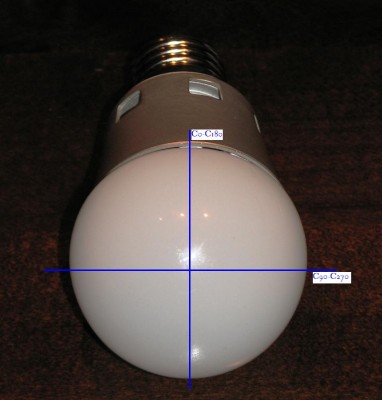
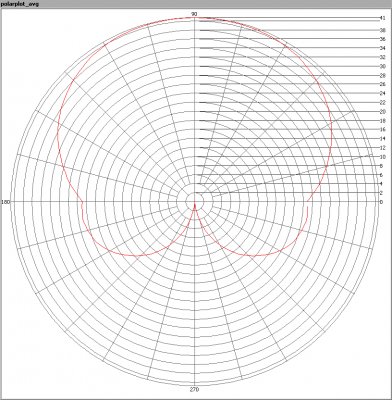
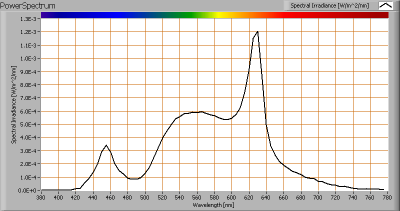
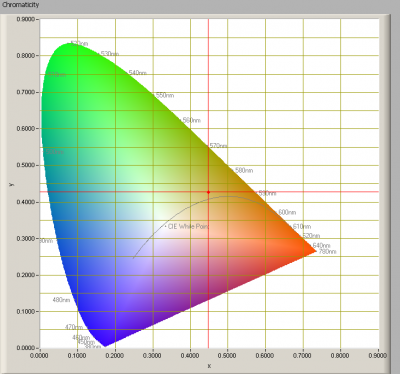
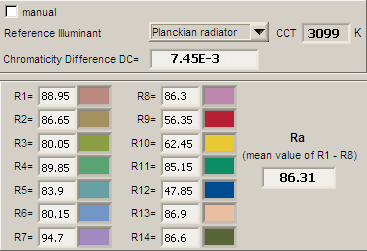
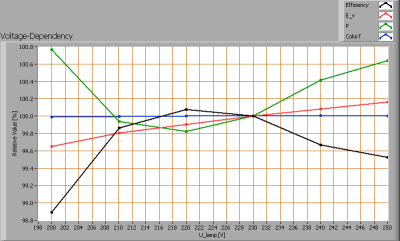
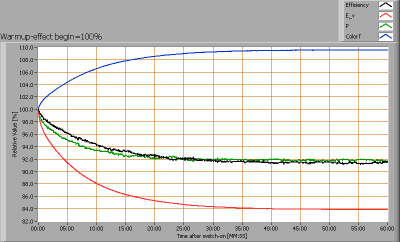
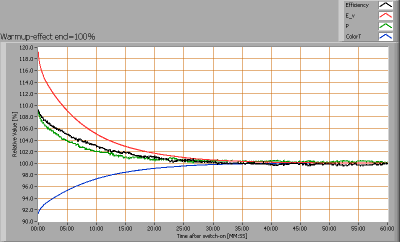
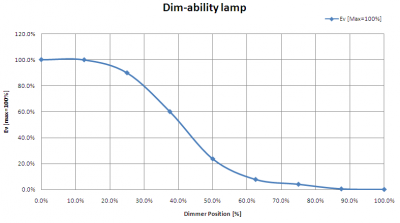





2 replies on “Lemnis – Pharox 300 E27 ledlamp.”
Morning,
WE’re interresting about Pharos. Do you have CE and Rohs?
please send us your price list and delivary conditions to France.
Thanks.
Philippe.
you can buys these at kuuala.com they are on sale for 24.99 until the end of November